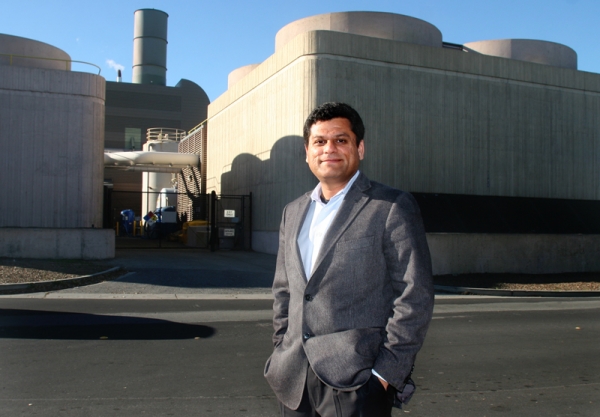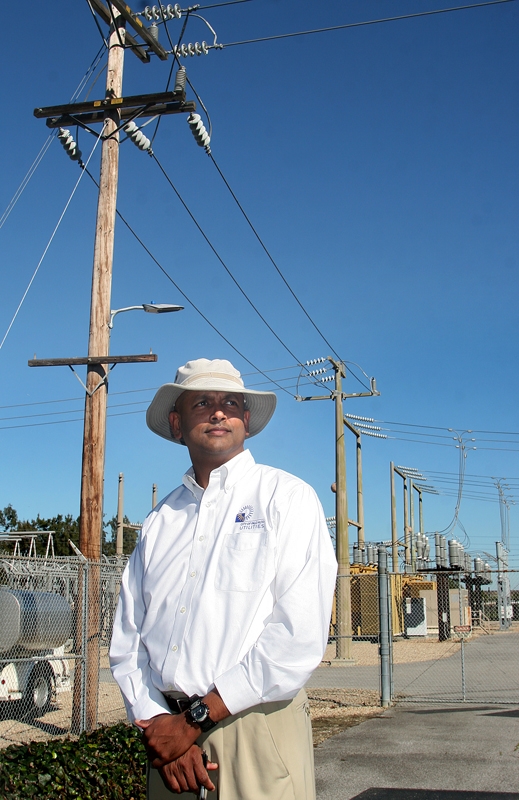Amit Narayan and Shiva Swaminathan arrived at their partnership from opposite directions.
Narayan, an inventor, entrepreneur and visiting professor at Stanford University, spent the bulk of his career designing complex computer systems and superconductor chips for devices such as smartphones and video games. He later focused his research on energy efficiency and began directing Stanford's Smart Grid program.
He is on the frontlines of research in the growing field of "demand response" -- a mechanism that encourages electricity consumers to voluntarily reduce their usage during peak hours.
Swaminathan, a senior resource planner at City of Palo Alto Utilities, has been thinking about practical ways to bring Smart Grid technology to the city's electricity customers. Given that the local utility doesn't have the size or resources of Pacific Gas & Electric, which already uses smart meters, city utility officials want to integrate brand-new, state-of-the-art technology without taking a major risk or betting the bank. The project also brought Swaminathan to demand response.
The Stanford researcher and the Palo Alto utilities engineer are now working together to bring the city its first rebate-based smart-grid program -- an 18-month pilot project targeting major commercial customers. If things go well, the program would later be expanded to the city's masses.
Narayan describes smart grids currently used by major utilities such as PG&E as "Demand Response 1.0." He wants to develop what he calls the "2.0 version," which would give customers additional information about peak days and electricity usage. The program would anticipate the days of greatest electricity use (mostly during the summer) and offer customers rebates if they cut back on electricity on those days. If everything works out, the customer would save money because of lower electric bills. At the same time, the city would no longer have to operate inefficient ("dirty") generators that remain idle for most of the year but only get harnessed during peak times. Thus, the environment would also win, Swaminathan said.
The partnership is exactly what Palo Alto officials are talking about when they call for the city to look beyond its borders for regional approaches to sustainability. At the council's Jan. 22 retreat, Councilman Greg Scharff pointed to the city's municipal utilities and the brainy, green university next door and concluded that there should be plenty of opportunities for the two to collaborate.
Mayor Sid Espinosa reiterated the point during his State of the City speech two days later, when he called for Palo Alto to serve as a "test bed" for sustainability programs and technologies emerging from Stanford.
"We have the incredible opportunities to test emerging technologies and practices right here in the city," Espinosa said in the address. "We must explore those opportunities."
So far at least, most of the collaborative efforts have occurred from the bottom up. Narayan began collaborating with the city staff through Steve Eglash, who as a member of the city's Utilities Advisory Commission and executive director of Stanford's Energy and Environmental Affiliates Program, personifies the bridge between the school and the city on issues of sustainability (The commission discussed and endorsed the project at its meeting Wednesday night).
Eglash said the school and the city already collaborate on several issues relating to utilities. In recent months, for example, officials from the two institutions have been talking increasingly about possible ways to provide backup power to one another. Stanford also regularly sends graduate students on internship assignments in the city's Utilities Department.
"Most of what's been happening up until now has happened based on mutual respect between two individuals or a small group of individuals, where one professor at Stanford and one staff member in Palo Alto realize while conducting their normal work responsibilities that there is something they can work on together that falls within the scope of their jobs and could help their institutions," Eglash said.
In the case of Palo Alto's smart-grid initiative, Narayan said he reached out to the city because he wanted to test his research work in a real-life environment.
"I was trying to connect with utilities so we could basically do something not in a vacuum but in real collaboration," Narayan told the Weekly.
For the Utilities Department, the partnership means world-class expertise and resource sharing. If the council approves the project, Narayan and his team of Stanford researchers and interns would analyze the results of the pilot program and help the city proceed with the next phase. The administrative cost for the city would total about $15,000 in the current fiscal year and $10,000 in 2012, according to a staff report.
"We're not investing too much in hardware," Swaminathan said. "We're focusing mainly on software tools to assess the customers' potential and to give them the tools to get involved in better managing their usage."
Narayan said the tools' features could expand in later phases. For example, the software could function much like Netflix, a popular entertainment service that allows users to rent and stream movies and television shows and then recommends similar programs. In the case of utilities, the smart-grid software could analyze the customer's profile and then alert the user to ways to save money and get better energy efficiency.
Espinosa told the Weekly in a recent interview that sustainability is just one of many areas where the city wants to work more closely with Stanford. Last year, city officials met with Stanford University President John Hennessy to discuss possible partnerships. More recently officials from the city and from Stanford's School of Engineering met to discuss a variety of Stanford's clean-tech, parking-management and bike-share programs, which the city could soon participate in.
Collaborations with Stanford on sustainability issues are but one of many possible regional partnerships the city is exploring, with the goals of reducing costs and improving services, Espinosa said.
"Could we become more structured in thinking about policy questions that we want answered, or technologies we want harvested, or projects that we want to explore so that we can have direct relationships with professors, graduate students and undergrads to benefit both Stanford and Palo Alto?" he asked.




Comments